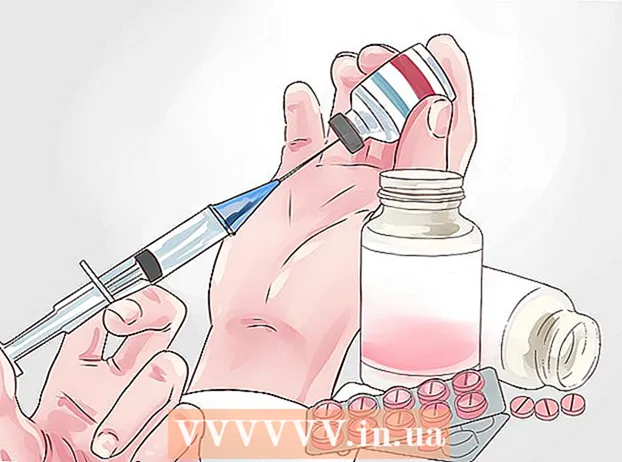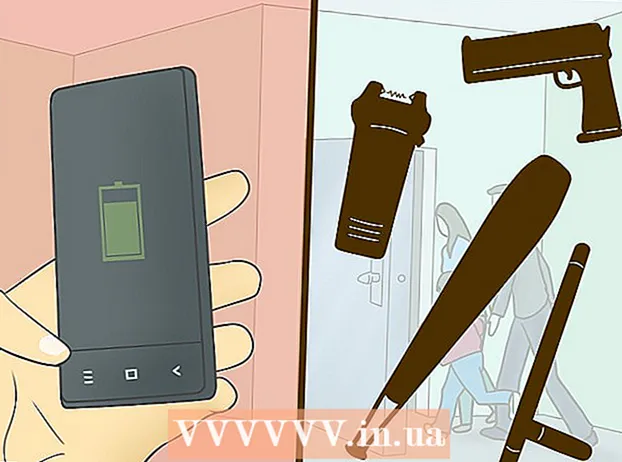
Content
- Steps
- Part 1 of 4: Professional advice
- Part 2 of 4: Treating First-degree Injuries
- Part 3 of 4: Treating Second-Degree Injuries
- Part 4 of 4: Treating third-degree injuries
- Tips
The superficial (underlying) calf muscle and the deeper soleus muscle together form the lower leg called the calf. These muscles connect the heel to the back of the knee; with their help, the leg bends in the lower leg, which is necessary when walking, running, jumping and other leg movements. Typically, stretching of the calf muscles occurs near the heel in the Achilles tendon due to sudden acceleration or deceleration. All muscle injuries are classified into three grades. In a first-degree stretch, several muscle fibers break; the second degree corresponds to more extensive damage to the muscle fibers; in the third degree, the muscle is completely torn. If the calf muscle is damaged, it is very important to establish an accurate diagnosis, since all subsequent treatment depends on it.
Steps
Part 1 of 4: Professional advice
 1 Make an appointment with your doctor. If you are having calf pain that does not go away within a few days, make an appointment with your therapist. The doctor will examine your leg and calf muscles, ask you about your lifestyle and how you may have damaged the muscles, and may even take an X-ray of your lower leg to rule out the possibility of a tibia or fibula fracture. However, the therapist is not a musculoskeletal specialist, so he or she will most likely refer you to a different, more specialized physician.
1 Make an appointment with your doctor. If you are having calf pain that does not go away within a few days, make an appointment with your therapist. The doctor will examine your leg and calf muscles, ask you about your lifestyle and how you may have damaged the muscles, and may even take an X-ray of your lower leg to rule out the possibility of a tibia or fibula fracture. However, the therapist is not a musculoskeletal specialist, so he or she will most likely refer you to a different, more specialized physician. - For musculoskeletal injuries, doctors such as an osteopath, chiropractor, physiotherapist, and chiropractor can also diagnose and prescribe treatment. However, you should still start with a visit to a therapist - he will be able to exclude other potentially serious causes of pain, such as thrombosis, vascular damage, Baker's cyst or, which requires immediate surgery, prolonged compression syndrome.
 2 Visit the appropriate specialist. In most cases, damage to the calf muscles is of the first degree, but if the tear is severe, surgery is sometimes required. In addition, pain in the calf area can occur due to serious diseases and injuries such as bone fracture, bone cancer, bone infection (osteomyelitis), venous insufficiency, sciatica due to herniated disc, complications of diabetes mellitus. As such, it may be necessary to see doctors such as an orthopedist (bone and joint specialist), neurologist (nervous system specialist), and physical therapist (muscle and bone specialist) to determine if the calf pain is caused by any serious disease.
2 Visit the appropriate specialist. In most cases, damage to the calf muscles is of the first degree, but if the tear is severe, surgery is sometimes required. In addition, pain in the calf area can occur due to serious diseases and injuries such as bone fracture, bone cancer, bone infection (osteomyelitis), venous insufficiency, sciatica due to herniated disc, complications of diabetes mellitus. As such, it may be necessary to see doctors such as an orthopedist (bone and joint specialist), neurologist (nervous system specialist), and physical therapist (muscle and bone specialist) to determine if the calf pain is caused by any serious disease. - To determine the cause of pain in the lower leg and make an accurate diagnosis, specialists can use X-ray, bone scan, MRI, computed tomography, ultrasound.
- Injuries to the calf muscle are quite common among those who play basketball, football or volleyball, as well as running and other athletics.
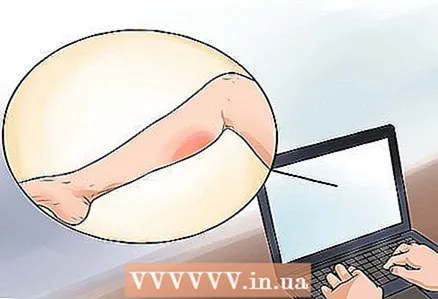 3 There are various treatments. It is necessary to visit a doctor who will make the correct diagnosis, establishing, if possible, the cause of the pain, and prescribe an appropriate treatment. Resting and home remedies (for example, ice packs) are only suitable for treating mild to moderate sprains of the gastrocnemius muscle, they are completely insufficient in the case of fracture, infection, tumor, diabetes mellitus or degeneration of the intervertebral discs: in these cases, more essential methods will be needed, which the doctor will recommend.
3 There are various treatments. It is necessary to visit a doctor who will make the correct diagnosis, establishing, if possible, the cause of the pain, and prescribe an appropriate treatment. Resting and home remedies (for example, ice packs) are only suitable for treating mild to moderate sprains of the gastrocnemius muscle, they are completely insufficient in the case of fracture, infection, tumor, diabetes mellitus or degeneration of the intervertebral discs: in these cases, more essential methods will be needed, which the doctor will recommend. - Read about calf injuries online (on medical websites) to understand the problem and learn more about the possible treatments and the results they bring.
- Factors contributing to muscle stretching include old age, past muscle damage, decreased muscle flexibility, lack of muscle strength, and fatigue.
Part 2 of 4: Treating First-degree Injuries
 1 Determine the severity of the injury. In most cases, damage to the gastrocnemius muscle is a slight stretch that resolves on its own within a week; The severity of the injury is the intensity of the pain, the degree of immobility, and the swelling. In first-degree injuries, up to 10% of muscle fibers are damaged, in which micro-ruptures occur. These injuries are characterized by bouts of moderate pain behind the lower leg, usually near the heel. They are accompanied by minimal losses in muscle strength and mobility. You can still be able to walk, run, and exercise, although you may experience muscle discomfort and tension.
1 Determine the severity of the injury. In most cases, damage to the gastrocnemius muscle is a slight stretch that resolves on its own within a week; The severity of the injury is the intensity of the pain, the degree of immobility, and the swelling. In first-degree injuries, up to 10% of muscle fibers are damaged, in which micro-ruptures occur. These injuries are characterized by bouts of moderate pain behind the lower leg, usually near the heel. They are accompanied by minimal losses in muscle strength and mobility. You can still be able to walk, run, and exercise, although you may experience muscle discomfort and tension. - Muscle stretching occurs as a result of their significant overload, leading to rupture of muscle fibers, which most often occurs in the places where muscles are attached to tendons.
- In most cases, first-degree calf muscle injuries are accompanied by a feeling of discomfort for 2–5 days, but they can be felt for several weeks, until complete recovery, depending on the proportion of damaged muscle fibers and treatment methods.
 2 Apply RICE therapy, or PLDP in Russian abbreviation. For the treatment of most muscle sprains and lacerations, the most effective method is RICE, which is an abbreviation for rest (Rest), ice (Ice), pressure (Compression) and lifting (Elevation). First, it is necessary to provide the damaged muscles with rest, that is, temporarily stop the activity that requires their tension. Secondly, it is necessary to use cold therapy, immediately after the injury, applying ice wrapped in a towel or bags of frozen gel to the damaged area to stop possible internal bleeding and reduce inflammation; at the same time, it is advisable to keep the leg in an elevated position, placing it on a chair or a stack of pillows (this also helps prevent inflammation). First, ice should be applied for 10-15 minutes every hour, then when pain and swelling have subsided after a few days, this can be done less frequently. Ice compresses, which are attached to the leg with an elastic bandage, will also help to stop bleeding from torn muscle fibers and the associated inflammation.
2 Apply RICE therapy, or PLDP in Russian abbreviation. For the treatment of most muscle sprains and lacerations, the most effective method is RICE, which is an abbreviation for rest (Rest), ice (Ice), pressure (Compression) and lifting (Elevation). First, it is necessary to provide the damaged muscles with rest, that is, temporarily stop the activity that requires their tension. Secondly, it is necessary to use cold therapy, immediately after the injury, applying ice wrapped in a towel or bags of frozen gel to the damaged area to stop possible internal bleeding and reduce inflammation; at the same time, it is advisable to keep the leg in an elevated position, placing it on a chair or a stack of pillows (this also helps prevent inflammation). First, ice should be applied for 10-15 minutes every hour, then when pain and swelling have subsided after a few days, this can be done less frequently. Ice compresses, which are attached to the leg with an elastic bandage, will also help to stop bleeding from torn muscle fibers and the associated inflammation. - Do not apply the bandage too tightly or leave it on for more than 15 minutes, as this can block blood flow to the damaged area, causing further complications.
 3 Take over-the-counter medications. Your family doctor may recommend anti-inflammatory drugs, such as ibuprofen, naproxen, or acetylsalicylic acid (aspirin), or standard analgesics (pain relievers), such as paracetamol, to reduce inflammation and pain caused by injury to the calf muscle.
3 Take over-the-counter medications. Your family doctor may recommend anti-inflammatory drugs, such as ibuprofen, naproxen, or acetylsalicylic acid (aspirin), or standard analgesics (pain relievers), such as paracetamol, to reduce inflammation and pain caused by injury to the calf muscle. - Please be aware that these medications are harmful to the stomach, liver and kidneys, so they should not be taken for more than two weeks in a row.
 4 Stretch your calf muscles. For moderate injuries, gentle stretching exercises can help relieve tension and improve blood circulation in the muscles. Stretching the muscles after the inflammatory phase forms scar tissue that is less flexible than normal muscle fibers. Stretching exercises help rebuild scar tissue, making it more flexible. Take a towel or elastic bandage and wrap it around your foot near the base of your toes. Then take its free ends in your hands and slowly pull towards you, gently lifting the foot and thereby stretching the calf muscle; hold it in a tense state for 20-30 seconds, then slowly release it. Do this exercise 3-5 times daily for one week until the pain in your calf subsides.
4 Stretch your calf muscles. For moderate injuries, gentle stretching exercises can help relieve tension and improve blood circulation in the muscles. Stretching the muscles after the inflammatory phase forms scar tissue that is less flexible than normal muscle fibers. Stretching exercises help rebuild scar tissue, making it more flexible. Take a towel or elastic bandage and wrap it around your foot near the base of your toes. Then take its free ends in your hands and slowly pull towards you, gently lifting the foot and thereby stretching the calf muscle; hold it in a tense state for 20-30 seconds, then slowly release it. Do this exercise 3-5 times daily for one week until the pain in your calf subsides. 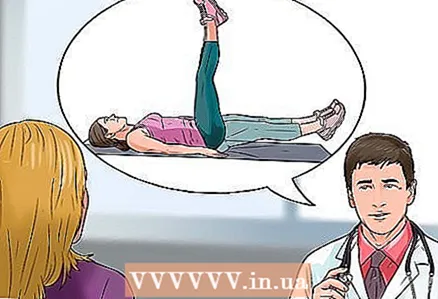 5 Before using any of the above methods on your own, be sure to consult with your doctor. Some exercise may delay your recovery and recovery.
5 Before using any of the above methods on your own, be sure to consult with your doctor. Some exercise may delay your recovery and recovery. - Warming up and stretching your calf muscles before exercising will help prevent muscle cramps, stretching, and tearing.
Part 3 of 4: Treating Second-Degree Injuries
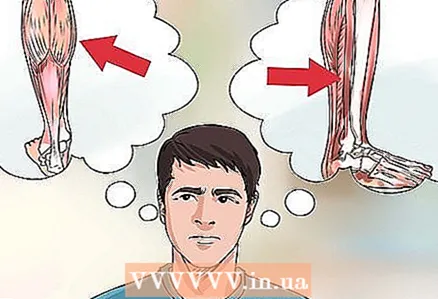 1 Learn to distinguish between stretching of the calf and soleus. With a fairly serious injury, it is important to determine which muscle is damaged more: the internal soleus or the external gastrocnemius. An MRI or ultrasound may be needed to better diagnose the location and extent of the injury. Second-degree injuries are characterized by extensive damage: up to 90% of the muscle fibers can be torn. These injuries are associated with more severe pain (defined as acute) and significant loss of muscle strength and mobility. There is more swelling, immediately after the injury due to internal bleeding in the muscle fibers, a bruise is formed.
1 Learn to distinguish between stretching of the calf and soleus. With a fairly serious injury, it is important to determine which muscle is damaged more: the internal soleus or the external gastrocnemius. An MRI or ultrasound may be needed to better diagnose the location and extent of the injury. Second-degree injuries are characterized by extensive damage: up to 90% of the muscle fibers can be torn. These injuries are associated with more severe pain (defined as acute) and significant loss of muscle strength and mobility. There is more swelling, immediately after the injury due to internal bleeding in the muscle fibers, a bruise is formed. - In second-degree injuries, the leg has limited mobility, especially when jumping and running, so you should refrain from such activity for several weeks or more.
- The gastrocnemius muscle is believed to be particularly susceptible to stretching due to the fact that it crosses two joints, the knee and the ankle, and contains a large number of fast phasic muscle fibers.
- The middle head of the gastrocnemius muscle is stretched more often than its lateral head.
 2 Apply RICE therapy. This method is also suitable for treating second-degree injuries, although longer ice packs (up to 20 minutes at a time) may be needed if the deeper soleus is mostly affected. Unlike minor injuries, where a few days of therapy is sufficient, more serious injuries will take a week or more.
2 Apply RICE therapy. This method is also suitable for treating second-degree injuries, although longer ice packs (up to 20 minutes at a time) may be needed if the deeper soleus is mostly affected. Unlike minor injuries, where a few days of therapy is sufficient, more serious injuries will take a week or more. - Most second degree injuries are accompanied by significant discomfort for 1–2 weeks after the injury, depending on the number of torn muscle fibers and the method of treatment. Full recovery and return to full physical activity may take 1–2 months.
- For moderate to severe muscle damage, anti-inflammatory drugs should be limited for the first 24–72 hours after injury, as their anticoagulant effect increases the risk of bleeding.
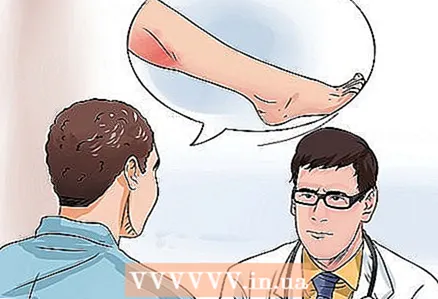 3 Get physical therapy. Second degree injury is a fairly serious musculoskeletal injury, usually accompanied by the formation of significant amounts of scar tissue and a marked loss of muscle mobility and strength. Therefore, after the initial swelling, bruising, and severe pain subside, ask your healthcare professional to refer you to a sports medicine or physical therapist who can offer you a variety of specific muscle strengthening and stretching exercises, massage treatments, and other therapies such as ultrasound (to reduce inflammation and disruption of scar tissue adhesion) and electrical stimulation (to strengthen muscle fibers and improve blood circulation).
3 Get physical therapy. Second degree injury is a fairly serious musculoskeletal injury, usually accompanied by the formation of significant amounts of scar tissue and a marked loss of muscle mobility and strength. Therefore, after the initial swelling, bruising, and severe pain subside, ask your healthcare professional to refer you to a sports medicine or physical therapist who can offer you a variety of specific muscle strengthening and stretching exercises, massage treatments, and other therapies such as ultrasound (to reduce inflammation and disruption of scar tissue adhesion) and electrical stimulation (to strengthen muscle fibers and improve blood circulation). - As a rule, resumption of full-fledged physical activity is recommended after cessation of pain and restoration of full mobility and strength of the calf muscles, which may take at least several weeks.
- Calf muscle injuries are most common in men between the ages of 30 and 50.
Part 4 of 4: Treating third-degree injuries
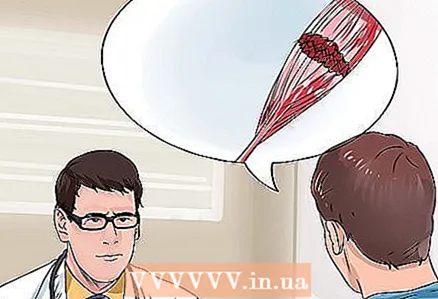 1 See a doctor immediately. A third-degree injury is a complete rupture of a muscle or tendon. It is accompanied by severe pain, which is burning and acute in nature, rapid, sharp inflammation and bruising, muscle spasms, and sometimes an audible "pop" when the muscle breaks. Contraction of the injured muscle also results in the formation of an easily palpable bulge. With a third-degree calf injury, you cannot walk, so help is usually needed to get to the clinic or hospital. Torn muscle fibers are unable to heal on their own, even when scar tissue forms, so surgery is required.
1 See a doctor immediately. A third-degree injury is a complete rupture of a muscle or tendon. It is accompanied by severe pain, which is burning and acute in nature, rapid, sharp inflammation and bruising, muscle spasms, and sometimes an audible "pop" when the muscle breaks. Contraction of the injured muscle also results in the formation of an easily palpable bulge. With a third-degree calf injury, you cannot walk, so help is usually needed to get to the clinic or hospital. Torn muscle fibers are unable to heal on their own, even when scar tissue forms, so surgery is required. - A sudden rupture of a tendon (such as an Achilles tendon) is often accompanied by excruciating pain, as if struck by something sharp. After surgery, you may need to take strong pain relievers for several weeks.
- If the calf muscle is severely damaged, bleeding into the foot may occur, resulting in a bluish-black tint.
 2 Get surgical help. Third (and sometimes second) degree injuries require surgery to rejoin the torn muscle fibers and / or tendons.It is important to perform the surgery as quickly as possible, because the longer the muscles are torn and compressed, the more difficult it will be to stretch them back to their normal position. In addition, internal hemorrhage can lead to local necrosis (tissue death) and even anemia caused by blood loss. Tears in muscle tissue heal faster due to sufficient circulation, while blood flow to the tendons is weaker and tears require longer treatment. After surgery, RICE therapy should be used.
2 Get surgical help. Third (and sometimes second) degree injuries require surgery to rejoin the torn muscle fibers and / or tendons.It is important to perform the surgery as quickly as possible, because the longer the muscles are torn and compressed, the more difficult it will be to stretch them back to their normal position. In addition, internal hemorrhage can lead to local necrosis (tissue death) and even anemia caused by blood loss. Tears in muscle tissue heal faster due to sufficient circulation, while blood flow to the tendons is weaker and tears require longer treatment. After surgery, RICE therapy should be used. - In the event of a complete rupture of the gastrocnemius muscle, an operation and about three months of subsequent treatment and rehabilitation will be required.
- After surgery, you may need to wear special shoes and crutches for a short time before proceeding to physical therapy.
 3 It will take time to recover. As with second-degree injuries, physical therapy is necessary after third-degree injuries, especially after surgery. A physical therapist may recommend special isometric, isotonic, and then dynamic exercises that need to be increased as muscle pain decreases and you recover. These exercises help you strengthen and repair your calf muscles. After 3-4 months, you will be able to return to sports, although the risk of re-injury in the future will be increased.
3 It will take time to recover. As with second-degree injuries, physical therapy is necessary after third-degree injuries, especially after surgery. A physical therapist may recommend special isometric, isotonic, and then dynamic exercises that need to be increased as muscle pain decreases and you recover. These exercises help you strengthen and repair your calf muscles. After 3-4 months, you will be able to return to sports, although the risk of re-injury in the future will be increased. - Injury to the calf muscle can be caused by lack of mobility or misalignment of the foot, so after treatment you may need special orthopedic shoes to avoid further injury.
Tips
- For a few days after the injury, use a heel pad in your shoes to lift the heel and contract the injured calf muscle, thereby reducing tension and pain. Remember to use it to avoid creating imbalance in the hips and lower back.
- Ten days after the injury, the scar tissue will have the same tensile strength as the adjacent muscles, after which it will be possible to begin therapeutic exercises.
- As a general rule of thumb to prevent injury (especially if you've had leg injuries before), remember to stretch your calf muscles before exercising and then cool down afterwards.
